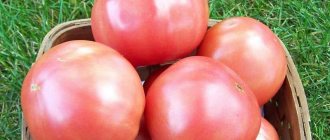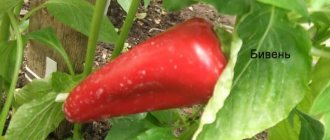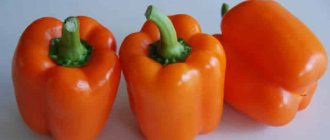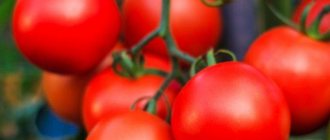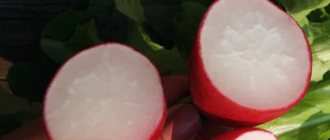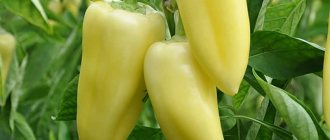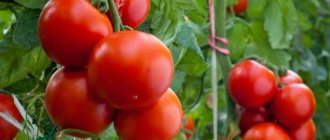The fruits of Belozerka pepper are in particular demand, as they retain their appearance and all their beneficial properties during storage and transportation. In addition, harvesting a large harvest from a small plantation is an equally important indicator of the crop variety. One of these unique varieties was presented by Moldovan breeders and registered in the state register in 1995. The variety was given the name “Belozerka”.
Description of the variety
In the 90s of the last century, scientists created a variety known today as Belozerka sweet pepper. Breeders, by crossing different crops, tried to obtain a variety of pepper that can grow in any climate - both in greenhouses and in open ground, with a good yield.
Their efforts were crowned with success: the Belozerka variety meets all the declared characteristics.
This is a determinate pepper with limited bush growth. It is also characterized by the following symptoms:
- plant height does not exceed 70 cm;
- from a strong central stem there are equally strong branches with dark green boat-shaped leaves;
- bushes do not require garter;
- the plant root system is well developed;
- white flowers in the form of stars;
- The variety is self-pollinating.
On a note. To increase productivity, other bee-pollinated pepper varieties are planted next to Belozerka.
general characteristics
Bushes of the Belozerka variety are not too tall, reaching only 50-70 cm. Each bush can contain up to 10-12 pieces at the same time. ovaries in varying degrees of ripeness. The stem of the pepper is hard and quite powerful; it can withstand such a load well, but in a strong wind it can collapse under the weight of the fruit.
The yield of Belozerka pepper remains stable even in unfavorable years. The flowers do not fall off even in extreme heat, continuing to set fruit all summer. With prolonged rainfall, fruit production is not reduced, but peppers can suffer greatly from fungal diseases. Low-growing and dense bushes are poorly ventilated, and the accumulation of moisture in the crown contributes to the spread of alternaria or late blight.
In central Russia and in the southern regions of the Urals and Siberia, the variety can also be grown in open ground. But most often Belozerka is recommended for greenhouses: a mid-season variety will not have time to yield the entire harvest in an open garden bed. Fruiting begins 135-140 days after sowing the seeds for seedlings, so the first peppers at technical ripeness can only be harvested in July. The biological phase of maturation begins even later.
From 1 Belozerka pepper bush you can harvest up to 2 kg of marketable sweet pepper. With average planting rates of 4-5 bushes per 1 m², the gardener manages to get a good return on his labors. To increase productivity, it is recommended not to leave peppers on the bushes until they are fully ripe, but to pick them at the stage of technical ripeness. In this case, the ovaries of the next age grow more actively and become larger. More flower buds are formed on the bushes; all nutrients are sent to the newly growing branches.
Fruits and yield
Belozerka produces cone-shaped fruits with elastic and juicy pulp. The surface of the fruit is glossy, smooth, the apex is slightly pointed. The fruits have several sides. The wall thickness is 4-7 mm.
The peppers themselves are average in weight and size - the weight of one fruit is 80-90 g.
The yield of the variety is high - during the season you can get up to 9 kg of vegetables from 1 sq. m.
The color of ripe fruits is bright red. They are stored for a long time and do not lose their beneficial and tasteful qualities.
This is a universal vegetable crop that is used both for canning and for daily cooking of various dishes:
- lecho;
- salads;
- soups;
- stuffing;
- adzhiki.
On a note. Bell pepper is rich in vitamin C; its regular use helps improve immunity, cleanses blood vessels, increases appetite, and normalizes blood counts.
Main characteristics of Belozerka bell pepper
The fruits of this pepper can ripen of medium size or quite large - their weight usually ranges from 85 to 145 g. The size and number of ovaries formed are significantly influenced by weather conditions.
Cone-shaped fruits can be up to 13-15 cm or more in length. The base of ripe fruits is wider than the tip - sharp and slightly elongated.
Belozerka peppers that begin to ripen have a smooth, even surface coloring dark green; when the fruits are ripe, their color can be different - greenish with a white tint, red, orange or yellow.
The walls of ripe fruits of this variety are thin - no more than 0.7 cm, the pulp is juicy with a slight crunch, quite sweet and tasty. The taste of Belozerka pepper is excellent.
Belozerka pepper - features of planting and growing the variety - video
The fruit contains a large amount of ascorbic acid,
which are the main nutritional and healing aspects of this vegetable.
On a note!
If bell pepper is constantly present in a person’s diet, then people’s immune system is strengthened, blood vessels and walls are cleansed of “bad” cholesterol, blood composition becomes better, and appetite improves.
The harvested Belozerka pepper tolerates transportation well in different conditions and can be stored in the refrigerator for quite a long time. Also, all ripe fruits are of universal use:
they can be eaten fresh, added to various salads and snacks, used in the preparation of hot first and second courses, and also made into various preparations for the winter and frozen.
Germination of seeds
The vegetable is cultivated using the seedling method. Seeds are germinated in a warm place with high humidity levels. As soon as the first shoots appear, the seeds are planted in the soil, which should be nutritious and loose. It is best to use a store-bought potting mix for vegetables or flowers.
Each plant is placed in a separate container - then it is easier to transplant them into open ground. At this stage, it is important to provide the seedlings with good lighting and watering (do not allow the soil to dry out).
Feeding
The crop is fed with a small amount of superphosphate and potassium fertilizers immediately after the appearance of cotyledon leaves . The second feeding is done when more than ten true leaves are formed and the pepper reaches 10 cm in height.
To do this, use chemical compositions at the rate of 15 g of superphosphate and 5 g of potassium per 5 liters of liquid at room temperature. The specified proportions must be strictly observed, otherwise the crop will be oversaturated with nitrates.
Important! Seedlings are not picked - Belozerka does not tolerate this procedure.
Plants planted in open ground are fed several times throughout their entire life cycle.
During the formation of the ovary and flowering, the first feeding is performed, the second - when the fruits ripen.
Features of cultivation
There are crops for which daylight hours should be short, up to 12 hours. Pepper is one of them; for a larger harvest, planting should be shaded a little.
The soil. The best beds with light and neutral soil are those in which cucumbers, pumpkins, zucchini or cabbage grew last season. Light, warmth, short daylight hours are the main factors in the high fruiting of heat-loving peppers. The acidity of the soil can be reduced with lime and dolomite flour, adding them when digging before planting seedlings.
Seedling. In water, in a couple of hours, full-fledged seeds for future seedlings are determined. They are soaked in a weak solution of potassium permanganate and biostimulator for 30 minutes, blotted with a napkin. The swollen seeds germinate already on the third day in containers under film, which were buried a maximum of one centimeter into the soil during sowing. It is recommended to sow seeds from mid-February. For two weeks, seedlings are hardened in the fresh air.
Pick. Peppers do not like transplanting, so it is recommended to plant them immediately in separate peat pots. Plants can be picked if they have three true leaves.
Belozerka pepper is one of the popular vegetable crops, which is grown in gardens and often planted in greenhouses.
Landing. The best time to move peppers into the ground is the last days of May or the beginning of June. Optimal planting pattern: 50x60 in a checkerboard pattern. Thickening of plantings will provoke diseases of the bushes. The seedlings are placed in the holes and the soil is well compacted around the stem.
Garter. As they grow, the bushes are tied up until the fruits begin to ripen. Sometimes the bushes are strong and may not require staking.
Molding. The bush is usually formed into two stems; stepsons and yellow and damaged leaves are removed as they appear.
Watering. Moisture-loving peppers are watered regularly with warm, settled water. The soil moisture under the bushes should be constant and moderate. When color appears, watering is carried out at the root twice a week, 5-6 liters.
Feeding. The seedlings are fed several times after planting with nettle infusion. Regular shallow loosening and weed removal has a beneficial effect on the superficial root system. Re-fertilize when planting with superphosphates and potassium fertilizers.
Advantages and disadvantages
Let us list the positive qualities of the Belozerka variety:
- beneficial for the health of the body and excellent taste,
- average time for harvesting high yields,
- resistance to weather conditions and immunity from major diseases and pests
- high profitability.
The disadvantages of the Belozerka variety have not been identified at the moment.
Pests and diseases
Pepper variety "Belozerka" has excellent immunity to major diseases. The hybrid is highly resistant to all traditional garden diseases: Alternaria, verticillium and other viral infections, wet, dry and crown rot. No chemical treatment required.
Pests do not carry out massive attacks on pepper bushes of the Belozerka variety.
We invite you to join our group on VKontakte or Odnoklassniki, where new articles are published, as well as news for gardeners and livestock farmers.
Open ground
Peppers are planted in open ground no earlier than mid-May, when there are no cold nights and sudden changes in air temperature during the day.
They do this as follows:
- holes 20 cm deep are dug at a distance of 30-40 cm from each other;
- the bottom of each hole is covered with humus - for good rooting of plants in a new place;
- the plant is taken out of the container along with a lump of earth, placed in a prepared hole and covered with earth up to the first leaves;
- water with warm water - 2-3 liters per bush.
Before planting seedlings in open ground, the bushes must be prepared - hardened off. First they are taken outside for the day, then left overnight. Hardening increases the endurance of the crop after transplantation.
Harvest and storage
There are two ways to harvest:
- The first is suitable for those who plan to use the peppers right away. For example, for cooking or homemade winter preparations. Harvesting occurs when the fruits reach biological maturity, when the peel acquires a characteristic scarlet or yellow tint.
- The second option is ideal for transporting fruits over long distances or for long-term storage for later use. In this case, the harvest is harvested when the fruits reach technical maturity.
Harvest peppers using pruning shears or scissors, cutting off the fruit and stem. Send peppers for storage without scratches, dents or other mechanical damage.
For large volumes, for better preservation of peppers, wrap them in paper napkins and place them in wooden boxes. This way they can last throughout the winter months. Check the peppers occasionally for rot and remove any damaged fruit if necessary.
Another good method for storing this vegetable is freezing. However, all peppers must be ripe. Rinse the vegetables in cool water and pat dry with a towel to remove excess moisture. Then remove the stalk and seed part. Cut the peppers into strips or cubes. Pack the cuts into plastic bags or food containers and place them in the freezer.
Pepper care
The Belozerka variety requires the usual care for most unpretentious crops - watering, fertilizing, weeding. The main thing is to prevent rotting, drying out, disease and protect it from pests.
Watering
Do not overdry the soil until cracks form. In hot weather, the frequency and amount of watering is increased - in dry weather, 3-4 liters of warm water are poured under one bush (2-3 times every 7 days).
Fertilizers
They are fed with both chemical and organic substances. Potassium, nitrogen or phosphate fertilizers are diluted with liquid in strict accordance with the instructions. To organically feed peppers, use humus, compost or dry chicken manure.
Important! You cannot fertilize the crop with fresh manure - the plants may die.
Soil aeration
The soil must be loosened periodically to improve its breathability and ensure good water absorption.
This is done carefully, otherwise there is a risk of disturbing the root system of the plants (penetration depth is no more than 7 cm).
Weeding
The grass is removed by hand or with a hoe as it grows around the Belozerka bush. Weeds prevent plants from receiving all the necessary microelements from the soil and developing.
If there is a lot of excess grass in the garden, the pepper begins to get sick and becomes more vulnerable to attack by insect pests.
Mulching
The main objective of the procedure is to retain moisture in hot weather. Mulch the hole using hay, straw or grass clippings. This provides the necessary moisture at the root part and keeps it cool.
Growing seedlings
To grow peppers in the ground, you first need to grow seedlings. It's not very difficult, but there are still subtleties.
Preparation and selection of seeds and soil
You can dry the seeds for planting yourself or buy them, but only from a trusted manufacturer. It is not uncommon to encounter seeds of questionable quality. Before planting, they must be treated against possible diseases and given strength. To do this, use several simple methods. For example, you can dilute a weak solution of potassium permanganate and keep the seeds in it for fifteen minutes. Then rinse and let dry.
You can use a solution of 3% hydrogen peroxide. You need to warm it up a little and keep the seeds in it for no more than five minutes. It will not only rid them of germs, but also provide additional oxygen to stimulate growth. You can soak the seeds in special biological preparations that stimulate growth. As a rule, their use is described in detail on the packaging.
To ensure that the seeds germinate well, you can diversify the composition of the soil. To do this, take equal parts of soil, preferably leafy soil, sand and humus. You can prepare another composition by taking two parts of humus and peat and one part of sand.
Important! In addition to treatment against microbes, the seeds need to be checked for quality by immersing them in water for a few minutes. Those that float will most likely not rise.
Sowing scheme and further care
Sowing can begin in mid-February.
Let us immediately draw your attention to the fact that Belozerka pepper does not like transplants. Therefore, it is better to immediately plant it in separate containers-pots, which will be up to 8 cm in diameter
Prepared soil is placed in the pots and the seed is lowered into it to a depth of about 5 cm. The pots are placed on a tray and covered with film until the first shoots appear, which usually appear on the second or third day.
After this, the film is removed and the seedlings are grown, avoiding drafts, at room temperature. The sprouts need to be watered, but not abundantly. You can add a teaspoon of hydrogen peroxide per liter of water to settled water. This solution will kill possible microbes in the soil and strengthen the roots, giving them additional oxygen.
It is recommended to feed seedlings with fertilizers. The first time this is done after two or three true leaves appear. To do this, dissolve a gram of potassium fertilizer and three times more superphosphate in a liter of water. Young plants are watered generously with this mixture. The procedure is repeated after two weeks, doubling the concentration of fertilizers in the solution.
Due to the fact that any plant leans towards the sun, the pots of seedlings need to be rotated periodically. Then the seedlings will not be tilted to one side. Also, the pot must have a hole for water to escape. If it stagnates, the seedling will become thin and unsuitable for planting in the ground.
When it gets warmer, the sprouts can be taken out into the open air for hardening. When it gets really warm, you can leave them outdoors overnight.
Important! Experienced gardeners do not recommend picking young sprouts of Belozerka pepper. It can not only slow down the development of seedlings for two weeks, but also lead to their death.
Diseases and pests
Treatment with special solutions against pests or diseases is carried out only when necessary. Plants are carefully inspected for damage to fruits or leaves. It is important to determine the real cause of the lesion in order to select an effective method of control.
The Belozerka pepper variety is resistant to blossom end, dry and wet rot, alternative, verticillium and viral diseases. Spraying with chemicals for diseases or pests is rarely necessary.
Disease resistance
This crop, like many selected varieties, is practically not susceptible to pest attacks and viral, fungal, and bacterial diseases. Bell pepper Belozerka is unfamiliar with the most common diseases of garden crops:
- Alternaria blight;
- rot;
- verticillium.
The only plant disease is blackleg. Rotting at the base of the leaves can begin due to waterlogging of the soil, excessive watering, or after heavy rains. This variety of bell pepper does not require a lot of moisture, so it is necessary to monitor the soil and carry out aeration by loosening the top layer.
Insecticides and fungicides are not used for treatment. For preventive purposes, bushes can be treated with a solution prepared from 30 ml of hydrogen peroxide and 5 liters of settled water. Spraying is carried out in the morning or evening once every two weeks. Also, in order to protect the bush from diseases, a slightly pink solution of potassium permanganate is used (for spraying).
Advantages and disadvantages
Belozerka sweet pepper has no significant disadvantages. Minor disadvantages include the lack of thick pulp and large mass, compared to other varieties.
But the advantages of “Belozerka” are obvious:
- high productivity;
- smooth and beautiful fruits;
- excellent taste even at the stage of technical ripeness, when the vegetables are still white with a green tint;
- long fruiting;
- resistance to various weather conditions;
- good transportability and keeping quality;
- resistance to viruses and fungi.
Medium ripening varieties
Medium-ripening varieties are no less popular among gardeners. Suitable for fresh consumption, canning, pickling and freezing.
Belozerka
Belozerka variety with red and yellow fruits
Belozerka
- Hybrid variety of medium fruit ripening.
- It is characterized by high productivity, resistance to pests and viral diseases.
- The fruits are medium-sized, weighing between 70-100 g.
- Thick-skinned vegetables with a wall equal to 0.7 mm.
- Green fruits appear first. Then their color changes to yellow, and at the ripe stage the vegetables become deep red.
- The good taste of the fruit, juicy and aromatic pulp, and long shelf life have made the variety universally popular.
Description:
- The height of the bush varies from 40 to 70 cm
- Friendly ripening of fruits
- Cone-shaped peppers weigh on average 80 g, wall thickness 7 mm
- Good transportability of fruits
- Recommended for growing in open ground
- Universal variety
ox ear
ox ear
ox ear
- Mid-season variety of sweet pepper.
- Technical maturity of the fruit occurs on days 97-99, and 125 days pass from sowing the seeds to harvesting.
- High-yielding variety Ox's ear. Up to 3 kg of fruits are collected from 1 m2.
- The plant is resistant to viral mosaic.
Characteristics:
- Bush height – 60-65 cm
- The length of the cone-shaped peppers is 10 cm, the thickness of the pulp is 0.8 mm
- Fruit weight is about 150 g
- Has good transportability
- Can be grown in a greenhouse, open ground, under film
- Resistant to viral diseases.
- Can be eaten fresh, cooked, canned.
Hercules
Refers to a variety with an average period of fruit ripening. Many gardeners put forward the hypothesis that obtaining a high yield depends not on which variety is chosen, but on whether it is suitable for cultivation in certain climatic conditions.
Therefore, in our unpredictable climate, it is recommended to cultivate proven varieties. Hercules has proven himself well.
What a giant! Pepper length – 12 cm
Hercules
- The leaves of the plant are dark green in color, with a slightly wrinkled texture clearly visible on their surface.
- The leaf is medium in size.
- The fruits on the plant are drooping; ripening begins 120 days after sowing.
- The fruits are cube-shaped, up to 11 cm wide and 12 cm long.
- The weight of one fruit is 200 g.
- Only during the period of biological maturity do vegetables acquire a rich red color.
- The rest of the time the flesh is dark green.
- Since the variety has a long growing season, it is better to sow the seeds at the end of February. It is recommended to transplant seedlings into open ground in late May-early June.
Large fruits ripen on semi-spreading bushes 0.5 m high.
Characteristics:
- Can be consumed fresh or stored for future use
- Juicy pulp, pleasant aroma, wall thickness - 0.7 cm
- High yield: each bush can produce 3 kg of fruit
- Pronounced disease resistance
Please be advised that the fruits of the Hercules variety can also be consumed at the stage of technical maturity, when they are dark green in color. This does not impair the taste at all. The fruits will not be bitter.
Projects of country houses for 6-10 acres: 120 photos, description and requirements | The most interesting ideas
Reviews
Let's look at some online reviews about pepper so that you can get a more objective picture for yourself and make a final decision about purchasing it.
Elena, Yekaterinburg: “ My parents plant Belozerka peppers every year and are very pleased with the result - the fruits are bright and early. Even after stewing the stuffed peppers, the color remains pleasant and the dish turns out delicious!”
Ivan, Moscow: “It’s a good pepper, although it’s not huge in size. The main thing is to fertilize it with humus, water it and mulch it in time, then the yield will not fail. I harvested an excellent harvest even in the cold summer.”
Lyudmila, Perm: “I like Belozerka for its beautiful and even fruits. Another plus is that you can collect unripe peppers and use them all season long (until the end of August). There is no harm to the plant, only benefit - after harvesting the first fruits, new ones appear faster.”
Pepper Belozerka: reviews from those who planted
Natalya, 45 years old, Moscow region: I grow bell peppers on my plot exclusively in a greenhouse - there these heat-loving plants do not suffer from changes in air temperature, develop faster and bear fruit better. Last year I planted a bed of Belozerka peppers as a test. I really liked this pepper - it practically did not hurt me, only once an aphid settled on it, which I quickly removed. The fruits are quite large, beautiful and very tasty. From one square of area I collected about 8 kg of ripe peppers, and this is a very good yield. I will grow this variety in the future.
Svetlana, 55 years old, Volgograd region: I have been growing Belozerka pepper on my plot for several seasons now. I liked the variety for its good yield and relative ease of care. The fruits tolerate transportation well and can be stored in the refrigerator for a long time. This is the second season I’ve been planting several beds with this pepper, and the harvest is enough for food, for canning, I even partially sell this pepper - they take it away from me quickly, because the fruits are beautiful and very tasty.
Belozerka pepper is one of the most popular varieties of this vegetable crop due to its high yield, resistance to most diseases and relative ease of care.
Recently searched:
